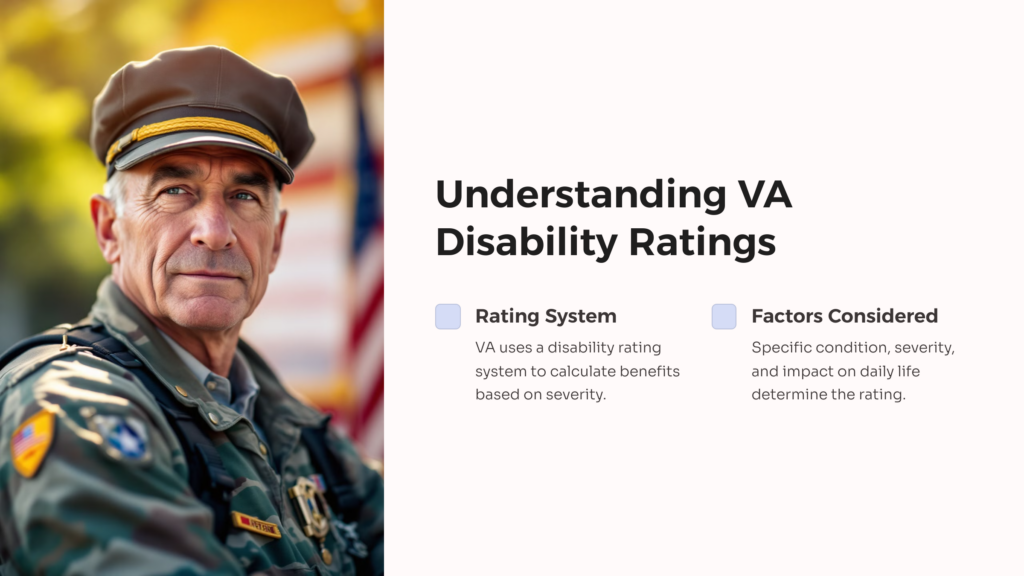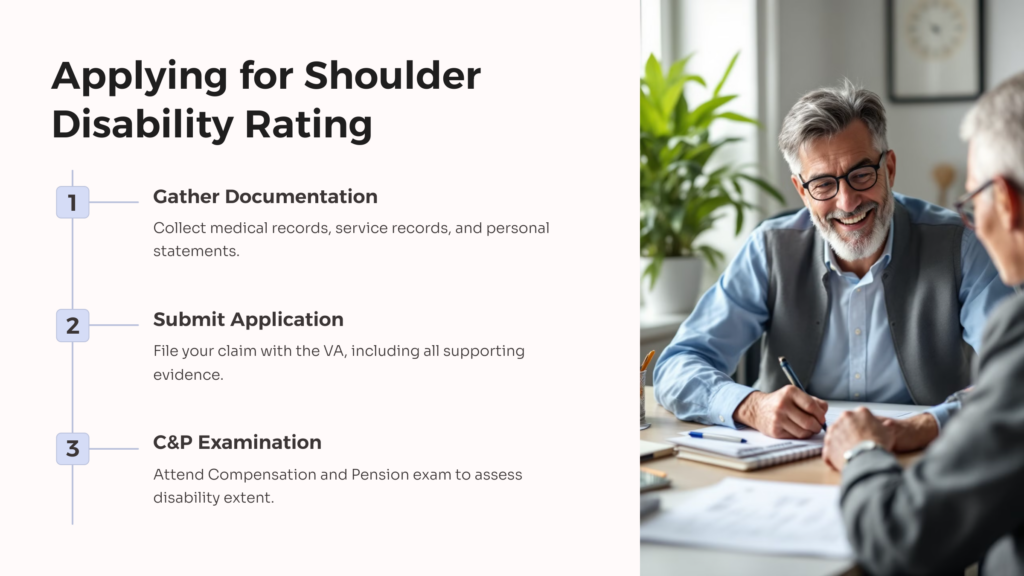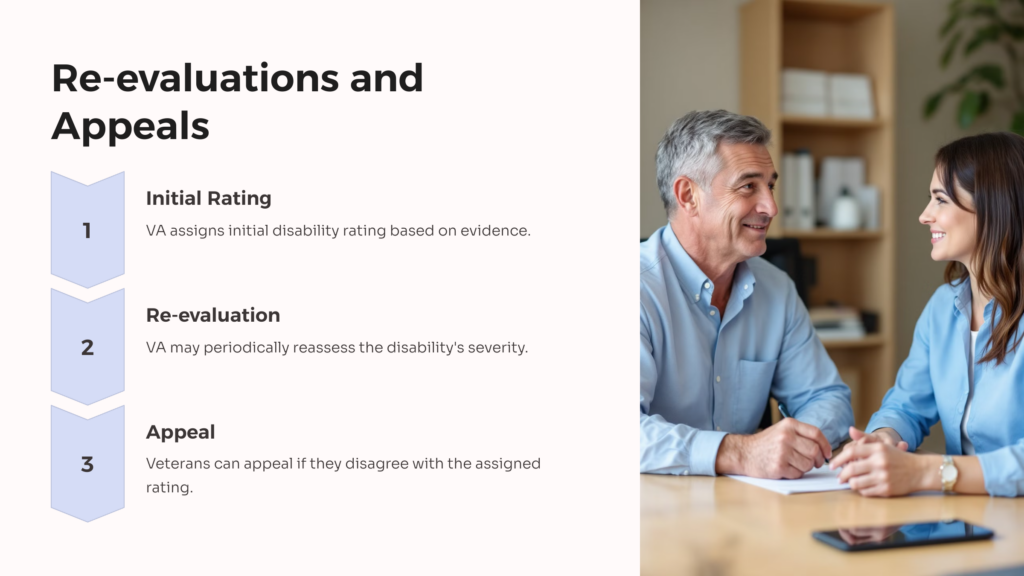The VA disability rating system is an indispensable system for understanding veterans disability levels and the corresponding VA disability benefits for U.S. veterans. As part of the framework instituted by the Department of Veterans Affairs, this disability rating system serves to provide veterans with deserved recognition and support for service-related disabilities. This article aims to provide an in-depth understanding of the VA shoulder disability rating – its importance, how it’s determined, recognized conditions, the application process, re-evaluations, appeals, and important tips for veterans facing this process.
II. Understanding VA Disability Ratings

To simplify the VA disability claim process, the VA uses a disability rating system to calculate VA benefits. This complex system is anchored on the severity of a disability, hence the VA calculates these ratings based on a stipulated schedule of ratings. A higher VA rating will qualify for a higher amount of VA disability compensation. The highest possible VA disability rating is 100%, representing total disability or impairment. To determine this VA rating, factors such as the specific condition, the severity of that condition, and its impact on the veteran’s daily life and ability to work are considered.
III. Shoulder Conditions Recognized by VA
Veterans Affairs recognizes several shoulder conditions as service-related disabilities, which can significantly impact a veteran’s quality of life. These conditions include, but are not limited to:
- Arthritis: A common degenerative joint condition that may be accelerated by the physical demands of military service.
- Shoulder Rotator Cuff Tear: Often resulting from repetitive motion or acute muscle injuries, a shoulder rotator cuff tear can lead to chronic shoulder pain and loss of function.
- Frozen Shoulder (Adhesive Capsulitis): This painful condition, characterized by stiffness and limited range of motion, can develop after an injury or prolonged immobilization.
Establishing the link between these conditions and military service for a VA disability claim can be challenging. Veterans must provide comprehensive medical records, service records, and, when possible, expert opinions to substantiate their claims. Additionally, the VA acknowledges that shoulder injuries don’t necessarily have to result directly from combat or other high-risk activities. Conditions caused by repetitive strain, overuse, or injuries sustained during routine military duties may also be considered service-connected disabilities, further broadening the scope for veterans seeking VA disability compensation.
IV. Understanding Shoulder Disability Rating
The VA rates shoulder and arm injuries using an intricate formula for rating disabilities. While there is no set rating for shoulder disabilities, the VA rates each VA claim on it’s own to calculate the right amount of VA benefits for each case. For veterans with multiple disabilities, the VA will calculate a combined disability rating.
One common issue affecting veterans is limiting motion in the shoulder, resulting from injuries or surgery, often a shoulder replacement. The analysis of limited motion involves a series of range of motion (ROM) tests using a goniometer. Apart from the motion limitation, pain, and weakened movement are also evaluated. The severity and the impact of these symptoms on the daily life of the veteran then determine the percentage assigned for shoulder disability.
Applying for Shoulder Disability Rating

Applying for a shoulder disability rating through the VA involves a structured and thorough VA claim process designed to ensure that all relevant information is considered. Key steps include:
- Application Preparation: Start by gathering all necessary documentation, including detailed medical records that outline the diagnosis, treatment, and progression of the shoulder condition. Service records that demonstrate when and how the condition arose during military service are also crucial.
- Personal Statements: Craft a detailed account of how the shoulder condition affects daily life, including physical limitations, pain, and the impact on work and personal activities. These statements should be specific, providing clear examples of how the disability impairs functioning.
- Supporting Statements: Collect statements from family members, friends, or colleagues who have witnessed the challenges posed by the shoulder condition. These testimonies add a personal perspective and can help validate the severity of the disability.
- C&P Examination: The VA schedules a Compensation and Pension (C&P) examination as part of the evaluation process. During the CP exam, a VA health care provider will assess the extent of the disability and confirm its connection to military service.
This comprehensive approach, combining medical evidence with personal and supporting testimonies, is essential for building a strong case for a shoulder disability rating.
Re-evaluations and Appeals

The VA occasionally re-evaluates veterans to ensure the accuracy of the current disability rating. The frequency of re-evaluations may be determined by factors like the possibility of improvement of the condition. Should a veteran disagree with the assigned rating of their injury or disability, they have the right to appeal the decision. This appeal may either result in an increase or a decrease in the disability rating, depending on whether the condition has improved or deteriorated. Thus, sufficiently preparing for re-evaluations and understanding the appeals process is crucial for all veterans.
Tips for Navigating the VA Shoulder Disability Rating Process

Navigating through the VA shoulder disability rating process can be daunting. Veterans are encouraged to be actively involved, be prompt in responding to VA requests, keep detailed documentation of their shoulder pain, and regularly update their medical and North Atlantic Treaty Organization (NATO) records to reflect their current state of health. Consulting an experienced VA disability attorney can provide further guidance for veterans. Their comprehension of VA procedures and regulations can greatly boost the chance of successfully obtaining an appropriate disability rating.
The VA shoulder disability rating system is undeniably an integral part of a veteran’s life, as it influences both the level of care and disability benefits they receive. Recognizing the significance of this, veterans are encouraged to engage actively in the process, equip themselves with essential knowledge, and ensure they receive the support they require. While the process may seem complex, the potential benefits make each effort toward understanding and effectively applying for disability ratings definitely worthwhile.
 AllVeteran.com Advisors
AllVeteran.com Advisors
With expertise spanning local, state, and federal benefit programs, our team is dedicated to guiding individuals towards the perfect program tailored to their unique circumstances.











